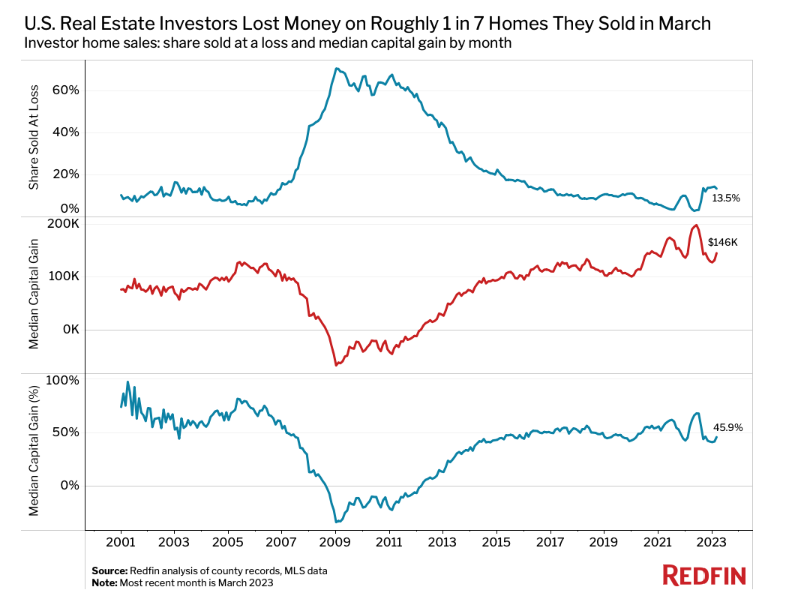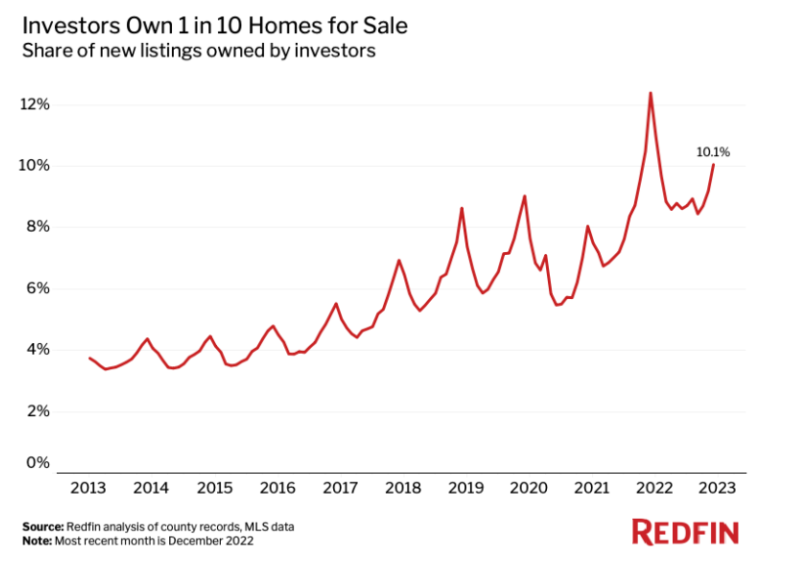 Roughly one of every seven (13.5%) U.S. homes sold by an investor in March 2023 sold for less than the investor bought it for, according to a new report from Redfin. That total is compared to February’s 14.5% rate—the highest since 2016. It’s also nearly triple the share of a year earlier and compares with a record low of 2.8% in May. By comparison, 4.8% of overall U.S. homes that sold in March sold at a loss.
Roughly one of every seven (13.5%) U.S. homes sold by an investor in March 2023 sold for less than the investor bought it for, according to a new report from Redfin. That total is compared to February’s 14.5% rate—the highest since 2016. It’s also nearly triple the share of a year earlier and compares with a record low of 2.8% in May. By comparison, 4.8% of overall U.S. homes that sold in March sold at a loss.
Redfin analyzed county records and MLS data across 40 of the most populous U.S. metropolitan areas for the report. Redfin defines an “investor” as any institution or business that purchases residential real estate, including both large companies and mom-and-pop investors.
While most housing investors still reaped sales gains, those gains have declined, as the typical investor who sold a home in March 2023 sold it for 45.9% more ($145,714) than the price they paid, down from 55.3% ($173,458) a year earlier, and a pandemic peak of 67.9% ($199,274) in June 2022. Redfin notes that gains don’t necessarily equal profits. Just because an investor sold a home for $145,000 more than they paid, did not equate to them making money, as they may have spent more than that on renovating the property.

“Home flippers aren’t reaping the gains they used to,” said Phoenix Redfin Agent Van Welborn. “I recently showed one of my buyers a three-bedroom single-family home in Glendale that was listed by an investor. My client ultimately found another house they liked better, and the investor ended up losing about $20,000. The investor bought the home for $450,000 and sold it for $480,000, but put $50,000 of work into it. The house also sold below the $550,000 list price after sitting on the market for almost four months.”
Investors are making less money selling homes—and losing money in some cases—because the housing market has slowed dramatically in response to rising mortgage rates. The average 30-year-fixed mortgage rate (FRM) hit 6.39% this week, down from the 20-year high of 7.08% in the fall, but up from 5.11% a year ago, and a record low of 2.65% during the height of the pandemic in January 2021. The rise in mortgage payments have eaten into investor profits, and sent the typical homebuyer’s monthly payment up nearly $300 year-over-year, which has slowed homebuying demand and pushed down sale prices.
“You might wonder why investors don’t just wait to sell until the housing market bounces back. Many long-term investors who rent their properties out are doing that, but many flippers—especially those who bought recently—can’t afford to,” said Redfin Senior Economist Sheharyar Bokhari. “Holding onto homes that aren’t producing income can be expensive because the owner is on the hook for property taxes, along with operating costs and monthly mortgage payments in some cases. Many short-term investors are also opting to sell because they know prices may have more room to fall and want to cut their losses.”
Roughly one in five (20.8%) homes sold by flippers in March sold at a loss, higher than the 13.5% share for investors overall. For the purposes of this analysis, Redfin defines a “flipper” as an investor that purchased a home and resold it within nine months.
Investors who rent out their properties are also seeing their returns shrink in some areas. The median U.S. asking rent fell 0.4% year over year in March—the first annual drop in three years—and 13 major metros saw larger declines. Owners of short-term rentals are getting hit as well. The Airbnb market is oversaturated with supply, and authorities are imposing tougher restrictions on hosts, driving some to sell.

Overall, investor activity has fallen significantly from the height of the pandemic, when record-low mortgage rates and soaring homebuyer demand drove up investor purchases. Redfin recently reported that investor purchases declined a record 46% year-over-year in Q4 of 2022.
Scanning the nation’s metros, in Phoenix, 30.7% of homes sold by investors in March sold at a loss—the highest share of the 40 metros Redfin analyzed and more than double the national rate. Phoenix was followed by Las Vegas at 28%; Jacksonville, Florida at 20.9%; Sacramento, California at 20.2%; and Charlotte, North Carolina at 17.4%.
The markets where investors are most likely to lose money are the places where home purchases—by investors and individual house hunters alike—soared during the pandemic. Many of those markets are also on the list of housing markets that are now cooling fastest. Pandemic boomtowns are seeing home prices and sales fall relatively quickly because housing costs surged to unsustainable levels during the pandemic, pricing out many house hunters, and elevated mortgage rates then added fuel to the fire.
“Most of the investors I see selling now are mom-and-pop investors,” said Las Vegas Redfin Real Estate Agent Shay Stein. “They’re selling because their long-term tenants are moving out, they want to put their money elsewhere, or they just want to get out because they have heartburn from 2008. The best time to sell would’ve been late 2021 or early 2022, but many of them are thinking that the next best time is now because the economy and home prices could slow further.”
Click here for more information on Redfin’s report on investor home sales.

 DSNews The homepage of the servicing industry
DSNews The homepage of the servicing industry









